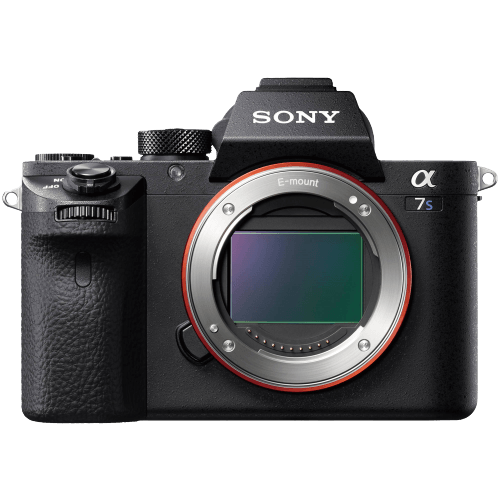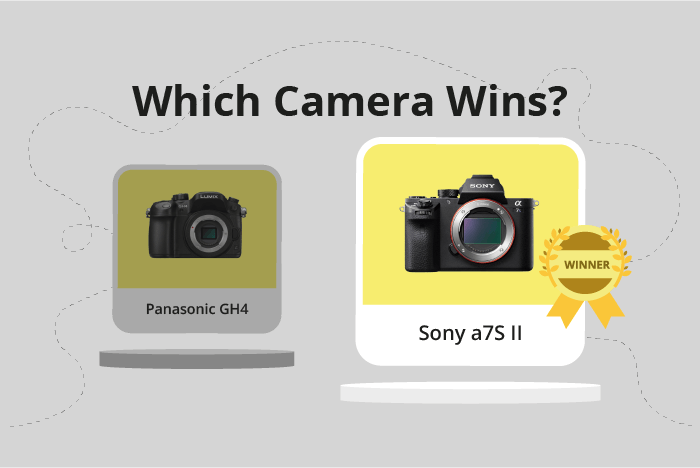Panasonic Lumix DMC-GH4 vs Sony a7S II Comparison
Panasonic Lumix DMC-GH4

Sony a7S II

The Sony a7S II edges out the Panasonic Lumix DMC-GH4 with a score of 60/100 compared to the GH4’s 58/100. Both cameras are mirrorless and were released in 2014 and 2015, respectively. They share similarities in size and weight, with the GH4 measuring 133 x 93 x 84mm and weighing 560g, while the a7S II measures 127 x 96 x 60mm and weighs 627g.
The a7S II’s higher score comes from its superior specifications, despite its higher launch price of $3000 compared to the GH4’s $1700. The GH4, however, is slightly lighter and more compact, which may appeal to some users.
Considering the scores and specifications, the Sony a7S II is the better choice for those seeking higher performance, while the Panasonic Lumix DMC-GH4 offers a more budget-friendly and compact option.
Panasonic Lumix DMC-GH4 vs Sony a7S II Overview and Optics
The Sony a7S II emerges as the winner in the optics comparison with a score of 66/100, while the Panasonic Lumix DMC-GH4 scores 52/100. Both cameras share some specifications, such as the CMOS sensor type and a similar processor, with the GH4 using Venus Engine IX and the a7S II using Bionz X.
The Sony a7S II outperforms the Panasonic GH4 in several aspects. First, it has a higher DXOMARK score for the sensor at 85, compared to the GH4’s 74. This means the a7S II produces better image quality. Additionally, the a7S II has a larger full-frame sensor, whereas the GH4 has a smaller Micro Four Thirds sensor. This leads to better low-light performance and a shallower depth of field for the Sony camera. Furthermore, the a7S II offers image stabilization, while the GH4 lacks this feature. The Sony camera also has a wider aspect ratio of 3:2, compared to the GH4’s 4:3 ratio.
On the other hand, the Panasonic GH4 has some advantages over the Sony a7S II. It has a higher megapixel count at 16, compared to the a7S II’s 12.2, resulting in more detailed images. The GH4 also offers a faster shooting speed of 12, while the a7S II has a slower speed of 5. This makes the GH4 more suitable for action photography.
Taking these factors into account, the Sony a7S II stands out as the better camera in terms of optics, with its higher DXOMARK score, larger sensor size, image stabilization, and wider aspect ratio. However, the Panasonic GH4 holds its ground with a higher megapixel count and faster shooting speed, making it a viable option for those seeking more detailed images and action photography capabilities.
Panasonic Lumix DMC-GH4 vs Sony a7S II Video Performance
The Panasonic Lumix DMC-GH4 outperforms the Sony a7S II in video capabilities, scoring 70 out of 100 compared to the Sony’s 56. Both cameras share some common video specifications, such as 4K maximum video resolution. However, the Panasonic GH4 has a higher maximum video dimension of 4096 x 2160, while the Sony a7S II’s maximum is 3840 x 2160. Additionally, the Panasonic GH4 includes a built-in time-lapse functionality, which the Sony a7S II lacks.
The Panasonic GH4’s higher video score is due to its better video dimensions and the inclusion of time-lapse functionality. These features make the GH4 more versatile in creating high-quality video content, providing users with more creative options and flexibility.
On the other hand, the Sony a7S II has a higher maximum video frame rate of 30fps, compared to the Panasonic GH4’s 24fps. This allows for smoother video playback and better slow-motion capabilities, making the Sony a7S II a more suitable option for those who prioritize capturing fast-paced action.
Both cameras have their strengths and weaknesses in video performance. The Panasonic Lumix DMC-GH4 offers a more comprehensive set of video features, making it the better choice for filmmakers and content creators who require versatility and advanced video options. The Sony a7S II, however, may be more appealing to users who prioritize capturing smooth, high-quality video in fast-paced environments. Each camera serves a distinct purpose and caters to different user needs in the realm of video capabilities.
Panasonic Lumix DMC-GH4 vs Sony a7S II Features and Benefits
The Panasonic Lumix DMC-GH4 outperforms the Sony a7S II in terms of features, scoring 70/100 compared to the Sony’s 57/100. Both cameras share some common specifications, such as a 3-inch screen size, lack of GPS, and the presence of WIFI connectivity. They also both do not have Bluetooth capabilities.
The Panasonic Lumix DMC-GH4 has a touchscreen, while the Sony a7S II does not. This allows for easier navigation and control when using the camera. Additionally, both cameras have a flip screen, but the higher feature score of the Panasonic Lumix DMC-GH4 suggests that it has more advanced and useful features overall.
On the other hand, the Sony a7S II has a higher screen resolution of 1,228,800 dots, compared to the Panasonic Lumix DMC-GH4’s 1,036,000 dots. This means that the Sony a7S II provides a clearer and sharper image on its screen.
In terms of features, the Panasonic Lumix DMC-GH4 is the better camera due to its higher score and the presence of a touchscreen. The Sony a7S II does have a higher screen resolution, which may be an advantage for some users. However, the overall higher feature score of the Panasonic Lumix DMC-GH4 makes it the more appealing option for those looking for a camera with more advanced and useful features.
Panasonic Lumix DMC-GH4 vs Sony a7S II Storage and Battery
The Panasonic Lumix DMC-GH4 outperforms the Sony a7S II in storage and battery with a score of 60/100, compared to the Sony’s 21/100. Both cameras accept SD, SDHC, and SDXC memory cards, but the Lumix GH4 also has two memory card slots, while the a7S II only has one. Additionally, the a7S II accepts Memory Stick Duo, Pro Duo, and Pro-HG Duo cards.
The Lumix GH4 also has a longer battery life, allowing for 500 shots compared to the a7S II’s 370 shots. Both cameras use different battery types, with the GH4 using a DMW-BLF19 and the a7S II using an NP-FW50. Neither camera offers USB charging.
The Lumix GH4’s advantages in storage and battery life make it a more reliable choice for extended shooting sessions and increased storage capacity. The a7S II does have the added flexibility of accepting Memory Stick cards, but this does not make up for its shorter battery life and single memory card slot.
Alternatives to the Panasonic Lumix DMC-GH4 and Sony a7S II
Are you still undecided about which camera is right for you? Have a look at these popular comparisons that feature the Panasonic Lumix DMC-GH4 or the Sony a7S II:

